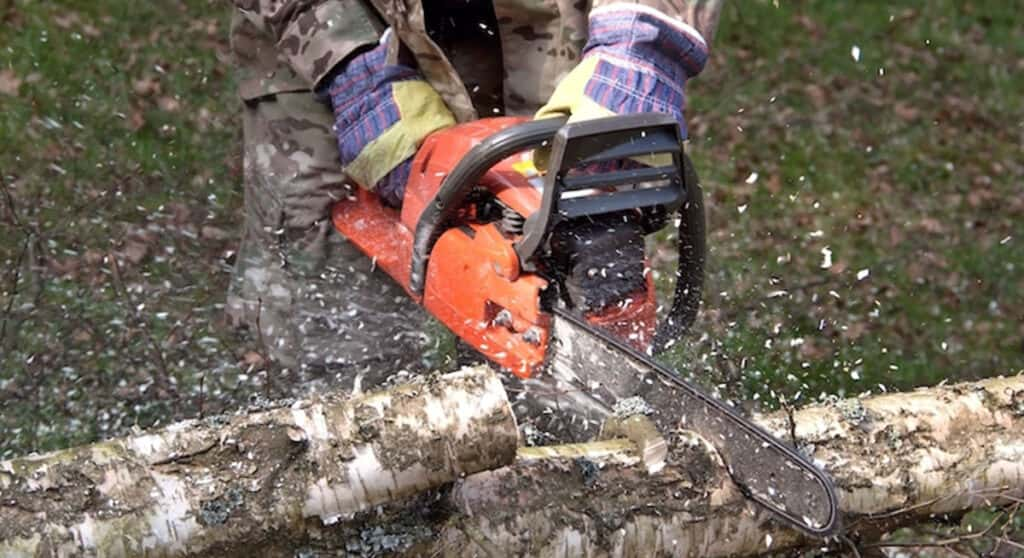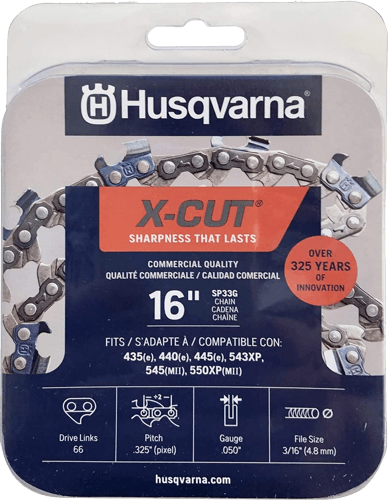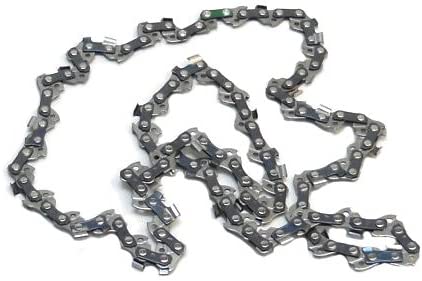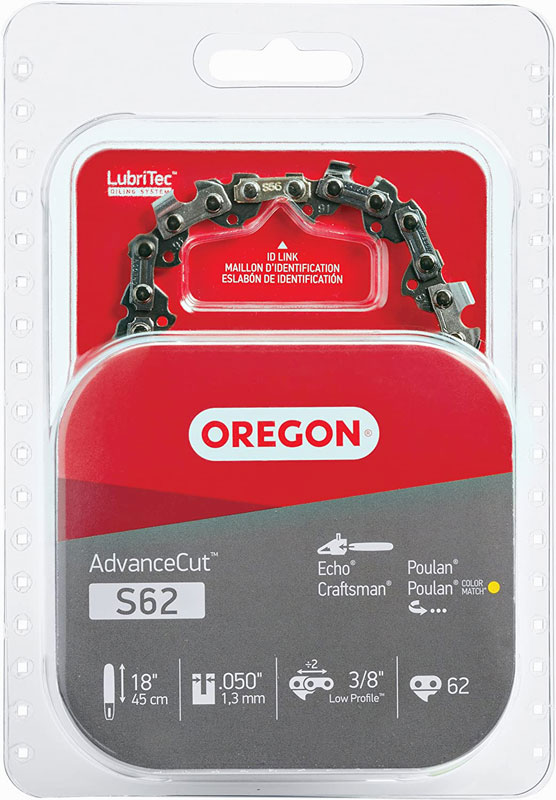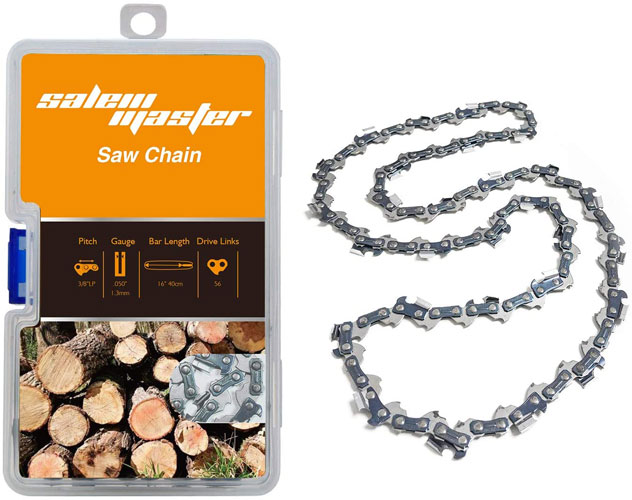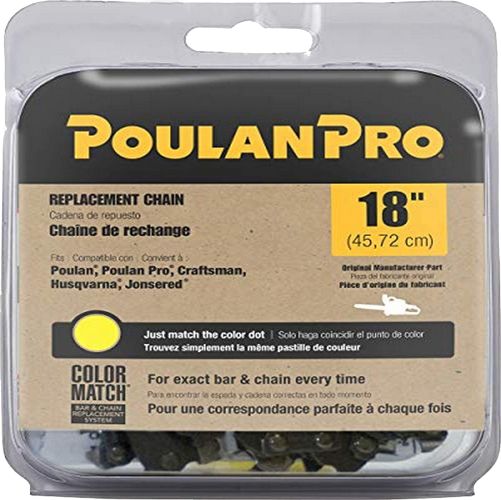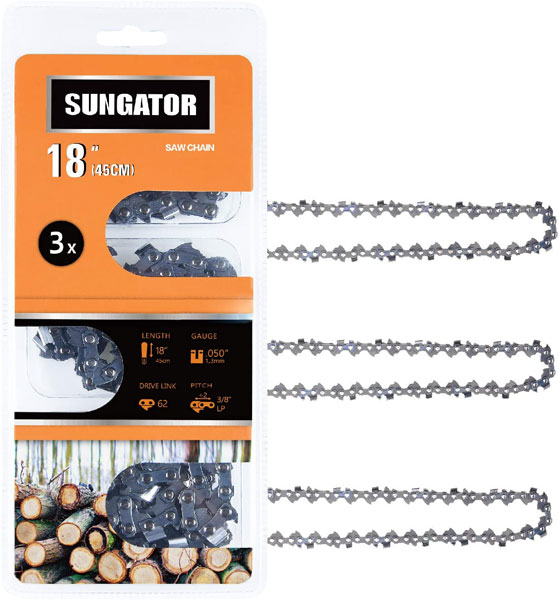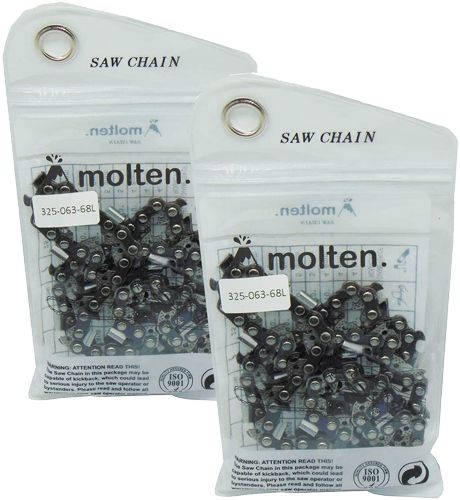Whenever you work on a project, whether small or large, it’s always worth the extra time and effort to pick out the best tool for the job. In the case of cutting down a tree with a chainsaw, using the wrong chain isn’t just inefficient – it’s also very dangerous.
In this article, we’re taking a look at what makes a chainsaw chain suitable for use on hardwood and the best of these products that you can buy right now. We will also be answering the question of whether it’s really necessary to switch up your saw chain when changing from softwood to hardwood, and what could happen if you used an incompatible chain.
Chain | Teeth shape | Length | Gauge |
|---|---|---|---|
Top pick | Semi-chisel | 56 drive links / 16-inch | 0.050” |
Semi-chisel | 66 drive links / 16-inch | 0.050 | |
Semi-chisel | 55 drive links / 16-inch | 0.043” | |
Semi-chisel | 62 drive links / 18-inch | 0.050” | |
Semi-chisel | 56 drive links / 16-inch | 0.050” | |
Semi-chisel | 18-inch | 0.050” | |
Semi-chisel | 82 drive links / 18-inch | 0.050” | |
Semi-chisel | 68 drive links / 18-inch | 0.063” |
Why you need a separate chain for cutting hardwood?
Hardwood like hickory, oak, or ash is valued because of how strong they are. This has made them the material of choice for applications such as furniture, construction, boat building, and the barrels used for wine fermentation. The strength of hardwood is also the biggest challenge when it comes to its treatment, making it necessary to choose carefully selected tools.
The main reason why anyone would chop down hardwood with a chainsaw instead of an axe is to cut down on the time spent doing the job. However, this advantage can be completely invalidated if you use a cutting chain that is unsuitable for hardwood.
You will likely end up sharpening the chain more often and using up more fuel. Moreover, the motor of the chainsaw can get overworked more easily which can result in long-term damage. The wrong cutting chain will inevitably get worn down earlier, which means you’ll be spending more money on buying new chains.
Safety is the most important thing to consider. As we’ve mentioned, using the wrong tool for the job can be a very dangerous practice. In the case of a chainsaw, using the wrong cutting chain increases the chance of a kickback. This is probably the worst thing that can happen while using a chainsaw and can result in serious injuries or death.
To go back to the question: do you need a separate chain for cutting hardwood? Absolutely. Not only is it safer, but it makes the job easier and saves money in the long run.
What to consider when picking a hardwood chainsaw chain
Picking the right chainsaw chain requires a bit of understanding of the parts of the chain. This goes not just for hardwood, but for picking the right cutting chain for your chainsaw for any other application. That said, let’s jump right into the things to look for when buying a chainsaw chain for hardwood.

Full chisel vs. semi-chisel
The teeth of a chainsaw chain are its cutting elements. Generally, chainsaw teeth can be classified into two based on their shapes – full chisel or semi-chisel. Full chisel teeth have a more square-cornered cutting surface, while semi-chisel teeth have rounded corners.
What’s the difference between the two? In a nutshell, full chisel teeth are faster and more efficient, but also get worn down easier and can create a lot of kickback. In contrast, semi-chisel teeth cut slower but do not need to be sharpened as frequently and have a relatively safer level of kickback.
For hardwood, we recommend a chainsaw chain with semi-chisel teeth. This is generally recommended for cutting any challenging type of wood, such as frozen wood or dirty wood. Hardwood tends to wear down the cutting teeth of a chain really quickly, which makes a more conservative semi-chisel chain a more efficient option.

Pitch
The pitch of a chain is simply a measure of the distance between the rivets. These are standard numbers that are either 1.4”, 0.325”, 3/8”, and 0.404”. By far, the most common pitch value is 3/8”. Larger pitch values are found in chainsaws that are designed for more aggressive cutting, as they displace more material with each round. If you’re just looking for a cutting chain replacement, then you’ll have to refer to the pitch value requirement of your chainsaw.

Gauge
The gauge is a measure of the thickness of the drive links of a cutting chain. Common gauge values are 0.043”, 0.050”, 0.058”, and 0.063”. The gauge of a chain does not have a pronounced effect on its performance.
The only important thing to consider is that the gauge of the chain matches that of the bar of the chainsaw. The differences between the gauge values are very small, making it theoretically possible for an incompatible chain to be installed in a chain saw. This is very dangerous as it can result in the chain coming loose during operations.

Length
The length of the chain is a function of its pitch and the number of drive links. Again, the compatibility of the chainsaw and the chain is the only thing that matters here. If your chainsaw does not provide this information in the manual, then you can simply count its drive links.

Kickback
A kickback is the most common cause of chainsaw-related injuries. This happens when either the chain at the tip of the chainsaw strikes an object or if the chainsaw gets “pinched” by wood in the middle of the cut. The impact of the chain suddenly stopping causes the chainsaw to launch up and back to the general direction of the user.
While there are a lot of tips on how to avoid a kickback, the selection of the proper chainsaw also plays a huge role in avoiding this accident. To make this easier for the buyer, most chainsaws sold today come with a tag that specifies how prone it is to cause a kickback.
If you’re a beginner, then it’s a safer option to buy a chainsaw with a green (low kickback) tag. Chainsaws with yellow tags are reserved for those who are more experienced. Even then, proper maintenance and use of your chainsaw are still essential in reducing the risk of a kickback.
How to change your chainsaw chain
If you’ve never changed a chainsaw chain before, the good news is that it takes less than five minutes if you know how to do it correctly. You also don’t need any fancy tools – if you have a set of screwdrivers and socket wrenches, then you’re pretty much all set.
To start, remove the side plate using a socket wrench. Release the tension on the bar by loosening the tension adjuster, which is a screw located at the base of the bar. When the bar is loose enough, the current chain can be removed.
Install the new chain on the bar, making sure that the cutting edge is facing the forward direction. Place the bar back in the chainsaw and secure it in place with the side plate but don’t tighter it all the way yet. With the bar in place, increase the tension using the tension adjuster. You want the chain to be just tight enough so that it snaps back in place when you pull it away from the bar. It is possible for the chain to be set too tight.
Finish up by tightening the bolts that hold the side plate in position.
If you need a visual demonstration of changing a chainsaw chain, we recommend this three-minute video from the PremiumSawChain channel:
The 8 best chainsaw chains for hardwood
When looking for a replacement chain, reliability and quality are our two top considerations. For this reason, our top pick is this cutting chain from Oregon, considered one of the top brands in this industry.
This semi-chisel cutting chain is compatible with 16-inch bars and has chrome-plated cutters that are designed to stay sharp longer, even when working with hardwood. Adding to its wear-resistant design are the signature LubriTec Oiling system and induction-hardened rivets.
In terms of cutting performance, the Oregon S56 AdvanceCut isn’t exactly the most aggressive. If you’re experienced with using chainsaws and prefer chains that cut rapidly, then you’re better off looking elsewhere. This is because the Oregon AdvanceCut is designed specifically to minimize kickback with low-vibration construction and semi-chisel cutting teeth.
Overall, the Oregon S56 AdvanceCut has become very popular as a reliable and low-maintenance cutting chain. It’s considered safe to use for beginners but might not be aggressive enough for more experienced users.
tech Specs | Pros | Cons |
|---|---|---|
Teeth shape: Semi-chisel Pitch: 3/8” Gauge: 0.050” Length: 56 drive links / 16-inch Kickback rating: Low | Safe from kickbacks | Slow cutting performance |
The X-Cut series is the signature line of saw chains by popular tool brand Husqvarna. True to its unique branding, the X-Cut chains have features that simply cannot be found in other run-of-the-mill chainsaw chains. The X-Cut chains are available for 16-inch, 18-inch, and 20-inch bars.
What makes the X-Cut chain so special? First is the fact that the chain comes pre-stretched from the factory, eliminating the need to constantly adjust the tension of your bar as you go along. The chain is made with a precise combination of steel and chrome which strikes an excellent balance of cutting performance and cutting capacity retention.
Even its cutting angle has been optimized to reduce the rate at which the edge gets dulled while still delivering good cutting performance. In terms of durability and sharpness, few chainsaw chains can even compare with the Husqvarna X-Cut series.
The one drawback is that the Husqvarna X-Cut is probably one of the most expensive replacement chains you can buy. While $30 doesn’t sound like a lot of money, it’s hard to overlook the fact that there are chains that cost about half that amount.
tech Specs | Pros | Cons |
|---|---|---|
Teeth shape: Semi-chisel Pitch: 0.325” Gauge: 0.050” Length: 66 drive links / 16-inch Kickback rating: Low | Pre-stretched design | Expensive |
US-brand Stihl is another entry in our list of brands that are highly trusted. If the name hasn’t tipped you off yet, this Picco Micro Mini chain is a low-profile chain replacement designed specifically for smaller chainsaws.
Despite the size, the cutting performance of this chain is quite satisfying. Since the chain has semi-chisel teeth, it does not cut aggressively but balances that out with longer retention of sharp edges.
What makes this lightweight cutting chain even more appropriate for small chainsaws is its low-vibration and low-kickback design. If you need to do some light yard work, then this chain should be more than good enough for the job.
The major criticism that this product receives is the fact that its quality can seem quite inconsistent. While most people get a product that performs well, there are also a few instances when the chain’s rivets fail early. There’s probably a bit of luck involved, but we’re hoping that Stihl can resolve these issues on product quality.
tech Specs | Pros | Cons |
|---|---|---|
Teeth shape: Semi-chisel Pitch: 3/8” Gauge: 0.043” Length: 55 drive links / 16-inch Kickback rating: Low | Suitable for small chainsaws | Quality control issues |
The S62 AdvanceCut is essentially identical to our top pick, which is another replacement chain from the ever-reliable Oregon brand. The main difference is that this version has more drive links to fit an 18-inch bar. It has the same pitch and gauge values, semi-chisel teeth, and level of quality as other Oregon AdvanceCut chains.
If you’re buying a replacement chain for a larger chainsaw, then the durability-enhancing features that Oregon provides are likely even more important. For more rugged jobs, the chrome-plated cutting teeth ensure that they don’t get worn down easily.
The vibration dampening features are also a great quality of life improvement when you’re cutting hardwood. The choice to use semi-chisel teeth makes the AdvanceCut chain a bit less aggressive, although that comes as a compromise for keeping the teeth sharper for longer.
In terms of price, the Oregon cutting chain isn’t the most expensive but is still a few dollars above what chains from other brands sell for. Considering its longevity and quality, we can argue that the few extra dollars are well worth it.
tech Specs | Pros | Cons |
|---|---|---|
Teeth shape: Semi-chisel Pitch: 3/8” Gauge: 0.050” Length: 62 drive links / 18-inch Kickback rating: Low | Inexpensive | Slow cutting performance |
This replacement chain from Salem Master is one that we would consider a “budget” option. It’s one of the cheaper options, which makes it a little more practical if you plan on buying multiple spare chains at a time.
Despite being inexpensive, the Salem Master chainsaw chain does not disappoint. It comes with chrome-coated semi-chisel teeth that do a good job of staying sharp, even with the demanding work of cutting hardwood. The heat-treated rivets give the chain a good measure of durability while the low-vibration design, which cuts down vibration by 20%, helps reduce damage to the chainsaw.
The low kickback rating makes the Salem Master replacement chain a good choice for those who aren’t highly skilled in yielding chainsaws. The low-vibration design means that it should also help make the chainsaw easier to control.
For such an inexpensive product, the chainsaw chain from Salem Master seems to have a minimal downside. While it’s not as premium as its more expensive counterparts, it still handles cutting through hardwood quite well. The only cause for concern would be frequent reports of the chain not fitting the intended chainsaws – we suggest double-checking the compatibility list provided by Salem Master.
tech Specs | Pros | Cons |
|---|---|---|
Teeth shape: Semi-chisel Pitch: 3/8” Gauge: 0.050” Length: 56 drive links / 16-inch Kickback rating: Low | Inexpensive | Fit compatibility issues |
The price of a Poulan Pro replacement chainsaw chain is similar to those of premium brands like Husqvarna. At this price range, the expectations become quite lofty. For the most part, the chain performs well enough to warrant a recommendation.
Made of heat-treated and hard-chromed steel, the Poulan Pro chainsaw chain is very durable and weather-resistant. Even when cutting through hardwood, the chain holds a sharp edge for an impressively long time. Based on user accounts, you can expect to get a few years of service from this chain before you will need to replace it.
In terms of cutting performance, the Poulan Pro chain isn’t the fastest on account of its semi-chisel teeth. However, it performs very smoothly likely as a result of its vibration-dampening features. As long as you keep the teeth sharp, you should not run into major issues using this chain.
Aside from the relatively high price tag, buyers of chains from Poulan Pro seem to be more commonly running into more compatibility problems than usual. If you’re buying this chain, check if your chainsaw is compatible with it first and make sure that you’re buying from a reliable retailer.
tech Specs | Pros | Cons |
|---|---|---|
Teeth shape: Semi-chisel Pitch: 3/8” Gauge: 0.050” Length: 18-inch Kickback rating: Low | Excellent durability | Relatively expensive |
When it comes to defying expectations, this pack of chainsaw chains from SUNGATOR definitely takes the cake. At less than $10 per chain, we can’t blame you if you expect the quality of these chains to be so terrible that they are unusable. We’re happy to let you know that it’s not entirely the case.
These SUNGATOR chains are made from fracture-resistant German steel with a coating of industrial-grade chrome. The rivet connections have been heat-treated for added durability. As with most other hardwood chains, the SUNGATOR chains feature semi-chisel teeth that do not get worn down easily.
What’s the catch? Probably the reason that these are sold in packs of multiple chains is the fact they can get dulled down easily. If you’re cutting hardwood, you will probably notice a massive drop in performance after just two or three trees.
Still, it’s tough to find fault with chainsaw chains that cost less than $10 a piece. Just remember to manage your expectations and be aware that you are buying replacement chains that are much cheaper than what popular brands offer.
tech Specs | Pros | Cons |
|---|---|---|
Teeth shape: Semi-chisel Pitch: 3/8” Gauge: 0.050” Length: 82 drive links / 18-inch Kickback rating: Low | Very inexpensive | Poor longevity |
8) MoltenSales 18-Inch Chainsaw Chain
These chains from Molten Sales, as they admit, are only OEM-equivalent. In simple terms, what this means is that they are cheaper versions of cutting chains from bigger brands like Oregon or Stihl with no promises of comparable quality.
As with many inexpensive products, these Molten Sales chains are a great demonstration of the adage that “you get what you pay for.” These chains, sold in 2-packs or 3-packs, were simply not designed to last very long. If you have a couple of hardwood trees that need to be cut down, make sure you have several of these chains on hand, as a single set might not last the day.
There is a bit of an upside to this more “disposable” approach to designing chainsaw chains. Since the chains aren’t designed to hold an edge for long, they also cut a bit more aggressively than other chains with semi-chisel teeth. This is great if you’re in a hurry and have a couple of spare chains that you don’t mind using until they are dull.
tech Specs | Pros | Cons |
|---|---|---|
Teeth shape: Semi-chisel Pitch: 0.325” Gauge: 0.063” Length: 68 drive links / 18-inch Kickback rating: Low | Cheap | Poor longevity |
Conclusion
Cutting down a hardwood tree is just about the most demanding type of work you can do with a chainsaw. If this is what you’re up against, then make sure that your chainsaw is equipped with a high-quality and appropriate cutting chain. The correct chain will make the job so much easier for you, not to mention safer. We know that nobody likes having a chainsaw kick up to their faces, but we imagine having to sharpen or change chainsaw chains frequently in the middle of a job to be only slightly less infuriating.

Carlo’s introduction to the wilderness was during his stint in geothermal and geological surveying, which brought him to remote and unusual hiking spots all over Southeast Asia. His outdoor experience has made him an expert in axes and other types of saws.

